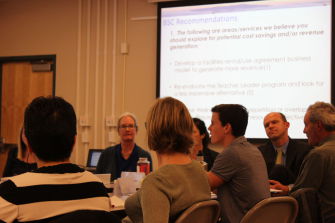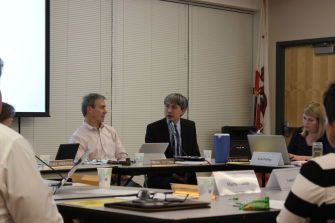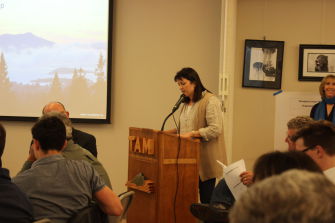The Tam District budget study committee recommended to the school board that the Wellness Center be examined to ensure that it is an effective use of resources. The committee presented on March 22 following five weeks of deliberation.

Twenty-three community members, including seven students, voiced their support for Wellness during Tuesday’s meeting. Six students from Redwood’s Peer Resource class, which has worked closely with the Wellness Center for its Condom Availability Program and its Wellness Week, presented their support for Wellness to the board.
“We need to have values, the definition of it, the goal of the mission statement of the school sitting there really big while you are going down your list of what to cut, where to add revenue,” said Betsy Zeger, chair of the Wellness Advisory Board, at the meeting. “Think about the values of the community. I think the community spoke loud and clear.”
Members of both the Redwood and Tam PTSA sent a letter to the board Monday night detailing their support for wellness programs. Lynn Garay, president of the Tam PTSA, reiterated the letter’s message during the meeting, specifically focusing on the absence of data presented to the budget committee.
“We were very concerned that without the CA Healthy Kids survey data being presented and without the outcomes of what we already know is going on in Redwood’s Wellness Center, how could anybody say ‘Yes I support Wellness’,” Garay said.

Drake student Noah Block, a passionate supporter of wellness in the district, shared similar concerns.
“Did they look at the Healthy Kids Survey? Did they talk to a Wellness counselor about what Wellness does?” Block asked. “Were they made aware that Marin County has the highest binge drinking rate of youth, of adults, and of the elderly in the state? Really what did they look at because I didn’t see that in the presentation.”
The wellness recommendation was one of three areas that the committee believed should be explored for cost savings. It also recommended that the district develop a facilities rental model to create more revenue and re-evaluate the teacher leader program. Other recommendations addressed areas that they believed should be maintained without exploration, and areas where services or programming should be increased, such as bringing back summer school and leaving libraries open until 7 p.m.

Prior to the public comment, board members held a public “workshop,” where they analyzed the current fiscal situation and fiscal projections for the next three school years. Board trustees also discussed the budget committee’s findings.
Trustee Laura Anderson voiced concern that the board needs more time to make budget decisions.
“We have read all of your emails. We have listened to everyone who has come up to this podium and what they feel is a priority, but we need more time. We need thoughtful time to look at all of this information and figure out what to do,” Anderson said.
Trustee Chuck Ford expressed a differing perspective, stressing the importance of making thoughtful decisions now to avoid having to make difficult decisions in the future.
“If we kick the can down the road we won’t be making thoughtful budget cuts. We’ll be making thoughtless budget cuts,” Ford said. “We need to do things now. This board needs to make thoughtful budget cuts so that a future board doesn’t have to make thoughtless budget cuts. Because that’s what it will come to.”
The budget committee developed its recommendations by using a “bucket” system to prioritize programs, according to San Andreas principal Corbitt Elson. There were nine “buckets,” according to the meeting presentation, including teaching, student learning, student and staff wellbeing, facilities, culture, extracurriculars, and staffing and administration. Throughout the process, the committee chose to rank programs based on importance, not the amount of funding they require, according to Kris Knutsen, a staff member at Drake and member of the committee.
The committee began prioritizing during its second meeting on Feb. 2, according to Lenny Gucciardi, a committee member who is part of the district’s TEAM program. In the remaining three meetings, the committee developed action statements and organized its priorities into recommendations, according to the presentation.
Gucciardi described the process as “understanding the budget and building what we wanted as an educational community from the ground up.”
The budget committee was composed of two board members, six parents, five students and community members, according to Tara Taupier, the assistant superintendent of educational services.
“We aimed for diverse representation across all stakeholder groups,” Taupier said.
The next step in the budget decision-making process will be for the board to study the committee’s recommendations and come to a budget decision.
“We all care about the students’ welfare. It may be a good learning tool to go to the wellness program and ask “Where do you get the most bang for your buck?” said trustee Leslie Lundgren.
The next board meeting will take place on April 5 at Tam.






